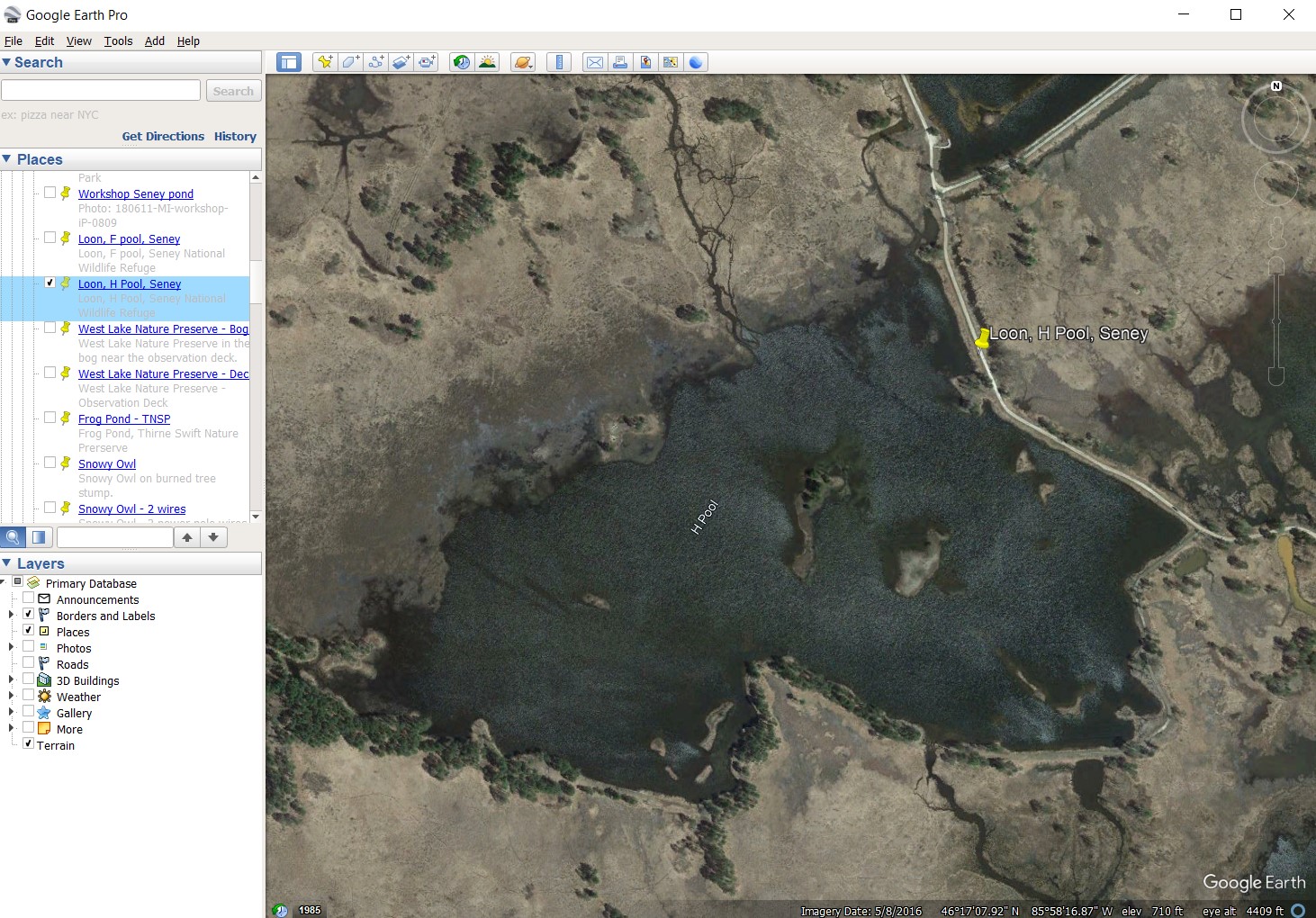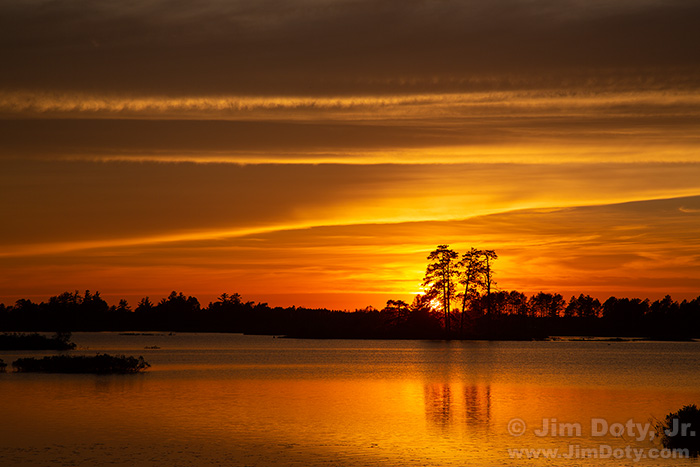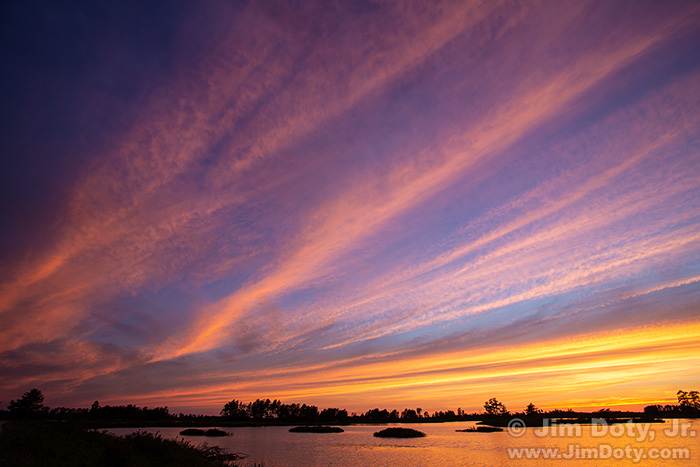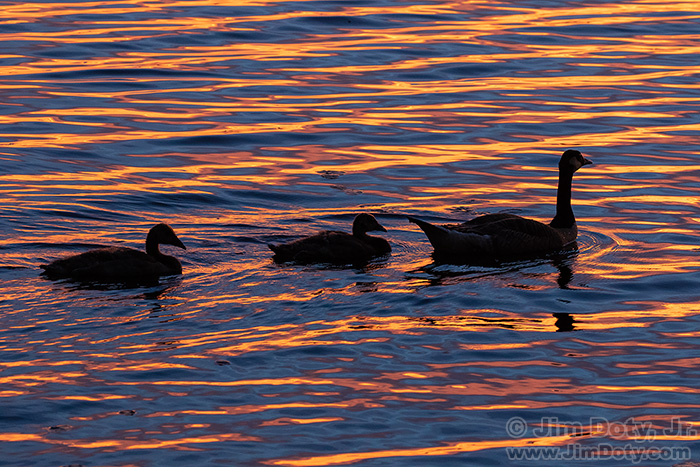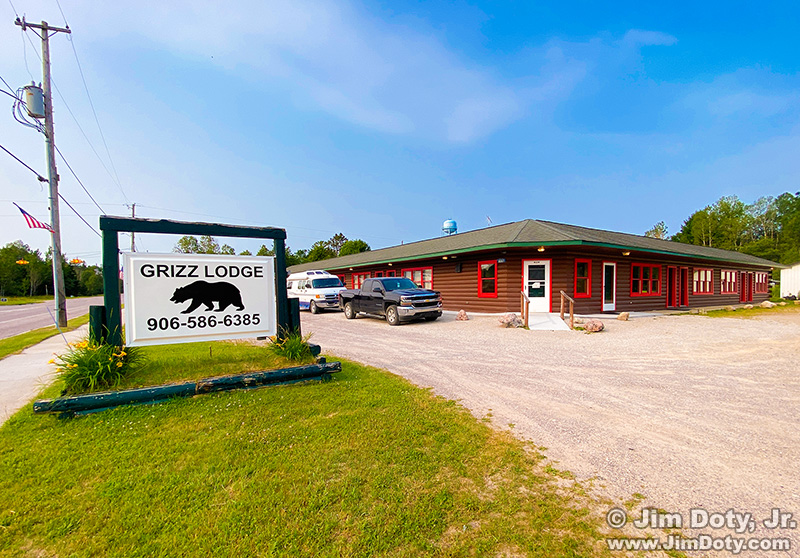Seney National Wildlife Refuge is one of my favorite places on the planet. Loons arrive every year in the spring, one of the many reasons to go to Seney. Not only are they fun to watch and photograph, there is nothing quite like hearing the call of a loon. Seney is in Michigan’s Upper Peninsula just north of Germfask. As an added bonus, ABJ has returned once again to Seney this spring. More about him later.
The loon (or loons) in these two photos were both photographed in the H Pool, but you can see loons at some of the other pools. Just take the one way road through the refuge and keep an eye out at all of the pools. To see everything, you will need to drive through twice. Take the longer fisherman’s loop on one trip, and take the shorter loop on the other trip. This year the refuge roads will be open to visitors from May 15, 2025 to October 18, 2025. For unexpected closures see the U.S. Fish and Wildlife link below.
This screen capture from Google Earth Pro shows where I was standing when I took the July 1, 2019 photo. According to the GPS data attached to the images, the June 30 photo from the night before was taken from pretty close to the same location on the road.
Spring is in the air and the mating activities of the loons at Seney National Wildlife Refuge are as complicated as a long running soap opera. This fascinating description was posted a year ago at the Seney Facebook page. “ABJ” is the world’s oldest loon with a verified age. He arrived at Seney again this April. ABJ was banded as a G Pool chick in June 1987 so he will turn 38 this June.
The following was posted at the Seney Facebook page a year ago yesterday.
ABJ SINGLE AGAIN – April 26, 2024
From Damon McCormick of Common Coast Research & Conservation:
Last May, despite a broken upper mandible that theoretically torpedoed his reproductive fitness in the eyes of potential mates, ABJ surprisingly paired and nested with a female, Daisy, who was two decades younger than his 36 years. This April, again claiming Seney’s E West Territory with Daisy, and with his bill fully regrown, ABJ’s breeding season, wedded to the prospect of hatching his 33rd and 34th chicks, was off to a promising start. But alas, for a third consecutive spring there is tribulation for the world’s oldest Common Loon of known age: He is back alone on H Pool, his bachelor pad of both recent seasons and his early years on the Refuge. Although the cause of the relocation was not documented, it is likely, based upon observations before and after, that he was forcibly evicted from E West by a challenging male. In such circumstances the resident female will often pair with the usurper, as occurred when Fe coupled with ABJ in 1997 after he bested her prior swain, Dewlap, in fierce battle. In this instance, however, Daisy also fled the territory; adding insult to eviction, instead of following ABJ back to H, she matched with a different male on adjacent F Pool, ABJ’s long-term home with Fe. Meanwhile, Fe herself has experienced an undramatic Refuge return on nearby I Pool, her breeding territory since 2022, and should initiate nesting with her unbanded mate within the week.
As noted in the previous update, and as freshly demonstrated by ABJ and Daisy, early spring is a time of comparative flux at the Refuge. ABJ and Fe’s 19 year-old daughter, Zelda, has moved from her D Pool abode of a decade to adjacent G, pairing with a 24 year-old male known as Jay. When ABJ found new love on E West last May, his vacant H Pool bachelor pad was quickly occupied by Z-Dot, Zelda’s 2018 chick and ABJ’s grandson. With the family patriarch back on H, this April Z-Dot has thus far only been observed intruding into other nearby territories. Should he drop into H at some point, he will receive no warm welcome from Gramps; while ABJ’s genes are pleased that ABJ’s lineage populates Seney pools, ABJ’s disposition, mirroring that of all Common Loons, does not extend behavioral courtesies to any adult who is not a current or potential breeding partner.
While April witnesses the highest frequency of divorce among Refuge partnerships, most pairs from the year prior will commence another breeding season together. On C Pool, 21 year-old Hook, a full brother to G Pool’s 24 year-old Jay, is again paired with a female known as Grant, who was banded on C as a successful mother in 2006; as she was at least four at the time, she is presently at least 22. Although back on C, Grant spent many years on adjacent B Pool coupled to Killer, who, now 31, is currently partnered for the seventh consecutive season with 14 year-old Jinx, another daughter to ABJ and Fe.
Once again, thanks to Common Coast volunteer Dani Fegan and Seney Visitor Services Specialist Jen Wycoff for their observations and documentation of Seney’s color-marked loon population.
Damon McCormick
Common Coast Research & Conservation
This was posted on Seney’s Facebook page a couple of weeks ago.
ABJ AGAIN RETURNS TO SENEY – April 15, 2025
From Damon McCormick of Common Coast Research & Conservation:
During a late spring, when Seney pools remain frozen well into April, resident loons, returning from a winter along the southern Atlantic Coast or Gulf of Mexico, must bide their time on nearby open water such as Lake Michigan, making daily reconnaissance flights to the Refuge and assessing from overhead the prudence in landing upon modest patches of liquid within otherwise iced impoundments. On Saturday, one of the first daredevils to alight in this risky manner was ABJ, the world’s oldest Common Loon of known age; banded as a G Pool chick in 1987, he will turn 38 in June.
ABJ touched down upon F Pool, his long-term turf with Fe, his partner of 25 seasons, with whom he hatched a record 32 chicks, many of whom later returned to the Refuge as breeding adults. Importantly, F Pool was not ABJ’s territory in 2024, and by Sunday morning the resident F male had forcibly relocated the patriarch to adjacent H Pool, his primary base of operations in recent years. Since the dissolution of his bond with Fe in spring 2022, ABJ has survived a broken bill, nested unsuccessfully with a mate, Daisy, who was twenty years his junior, and briefly dallied with the female, Aye-Aye, who precipitated his split with Fe. He begins his 35th season as a Seney adult with the same overarching objectives as all Common Loons who are currently dropping into the Refuge’s melting pools: claim a territory, procure a mate, ward off challenges from would-be usurpers, share egg incubation duties for roughly 28 days, hatch one or two downy chicks, and diligently feed and protect them throughout the summer such that they survive to fledge in the early autumn.
Since 2022 Fe has resided on I Pool, also adjacent to her former F home with ABJ. Although she was not spotted this weekend, at this early date there is no reason to assume that she will not re-materialize at Seney in the coming days.
Thanks to Dani Fegan for once again confirming ABJ’s return to the Refuge.
Lodging
My favorite place to stay when I am photographing Seney and other places in the area is Grizz Lodge in Germfask. I have been staying here on photo trips for over 20 years and it has changed names and owners several times, but it has always been a good place to stay.
Food
Tovey’s Jolly Inn, right next door to Grizz Lodge, serves a huge breakfast and good food any other time of day. I was there with another photographer so you are looking at both of our breakfasts.
Photo Data
Loons: Both images were created with a Canon 7D Mark II, and a Canon EF 100-400mm zoom lens at 400mm. Morning loon: f/8, 1/1000, ISO 400. Sunset loon: f/8, 1/80 second, ISO 200.
Sunset: Both images were created with a Canon 5D Mark III camera. The first Sunset photo was created with a 24-105mm lens at 105mm. f/11, 1/160 second, ISO 100. The second sunset photo was created with a Canon 17-40mm lens at 17mm. f/8, 1/15 second, ISO 100.
Canada Geese: Canon 7D Mark II, and a Canon EF 100-400mm zoom lens at 400mm. f/8, 1/80 second, ISO 1600.
Links
Seney National Wildlife Refuge – U.S. Fish and Wildlife page with dates the refuge roads are open and other announcements and information.
Seney National Wildlife Refuge – Facebook page.
Tovey’s Jolly Inn – Facebook page



